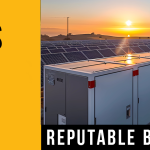
In the last 15 years, the increase in renewable energy sources such as photovoltaic and wind energy has accelerated significantly. At the same time, manufacturing and installation costs, especially for PV systems, have fallen significantly, making this energy source one of the cheapest and cleanest forms of energy, depending on the location. With the increase of fluctuating renewable energies in an electrical grid, the need for compensation possibilities at times when renewable energies are not available increases [1]. One possibility is the use of electrochemical energy storage such as lithium-ion, lead-acid, sodium-sulphur or redox-flow batteries. Additionally, combinations of hydrogen electrolysis and fuel cells can be used [2]. Batteries can be adapted in a flexible and decentralised manner depending on the respective requirements and are scaleable from a few kW/kWh for e.g. domestic storage up to systems of several MW/MWh for grid storage. The different types of electrochemical energy storage systems have different physical/chemical properties, which affect the cost of the system. It is important to note that the cost of the storage system over its lifetime (levelised cost of storage – LCOS) is a critical factor used in selecting the most suitable system for a particular application [3]. For example, the investment costs for lead-acid batteries are significantly lower than for all other technologies, but the service life is very short.
Technologies with similar investment costs at higher lifetimes result in a lower levelised cost of storage, but to be precise additional factors such as recycling, energy efficiency and maintenance costs have to be considered. A battery with a high efficiency, low recycling effort, low investment and maintenance costs and great freedom of scalability to meet the requirements of the application would be an ideal system. In electrical networks there are different storage time requirements: short-term storage, medium-term storage and long-term storage. The shorter the storage time, the more suitable are physical storage devices such as capacitors. Batteries are suitable for applications ranging from a few minutes to several hours. In addition, mass storage systems such as electrochemical hydrogen generation (power-to-gas) are particularly suitable for long-term storage of several weeks.
Redox flow principles
All electrochemical energy storage systems convert electrical energy into chemical energy when charging, and the process is reversed when discharging. With conventional batteries, the conversion and storage take place in closed cells. With redox flow batteries, however, the conversion and storage of energy are separated [4]. Redox flow batteries differ from conventional batteries in that the energy storage material is conveyed by an energy converter. This requires the energy storage material to be in a flowable form. This structure is similar to that of fuel cells, whereby in redox flow batteries, charging and discharging processes can take place in the same cell. Redox flow batteries thus have the distinguishing feature that energy and power can be scaled separately. The power determines the cell size or the number of cells and the energy is determined by the amount of the energy storage medium. This allows redox flow batteries to be better adapted to certain requirements than other technologies. In theory, there is no limit to the amount of energy and often the specific investment costs decrease with an increase in the energy/power ratio, as the energy storage medium usually has comparatively low costs. Figure 1 shows the general operating principle of redox flow batteries. The energy conversion takes place in an electrochemical cell which is divided into two half cells. The half cells are separated from each other by an ion-permeable membrane or separator, so that the liquids of the half cells mix as little as possible. The separator ensures a charge balance between positive and negative half cells, ideally without the negative and positive active materials coming into direct contact with each other. In fact, however, separators are not perfect so some cross-over of the active materials always occurs and this leads to the self-discharge effect.





